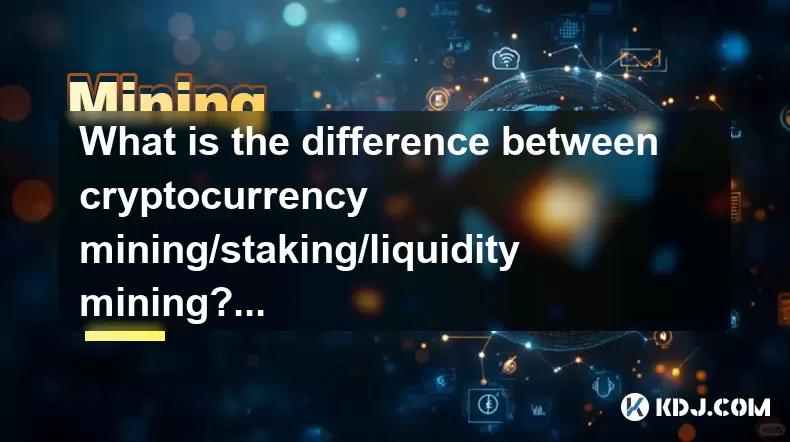-
 Bitcoin
Bitcoin $113900
-1.39% -
 Ethereum
Ethereum $3517
-4.15% -
 XRP
XRP $3.009
1.59% -
 Tether USDt
Tether USDt $0.9997
-0.04% -
 BNB
BNB $766.8
-1.41% -
 Solana
Solana $164.6
-2.38% -
 USDC
USDC $0.9998
-0.02% -
 TRON
TRON $0.3277
0.65% -
 Dogecoin
Dogecoin $0.2023
-1.67% -
 Cardano
Cardano $0.7246
0.05% -
 Hyperliquid
Hyperliquid $38.27
-4.77% -
 Sui
Sui $3.528
-0.52% -
 Stellar
Stellar $0.3890
-0.73% -
 Chainlink
Chainlink $16.16
-2.69% -
 Bitcoin Cash
Bitcoin Cash $539.9
-4.38% -
 Hedera
Hedera $0.2425
-2.00% -
 Avalanche
Avalanche $21.71
-0.97% -
 Toncoin
Toncoin $3.662
5.73% -
 Ethena USDe
Ethena USDe $1.000
-0.02% -
 UNUS SED LEO
UNUS SED LEO $8.964
0.35% -
 Litecoin
Litecoin $107.7
2.33% -
 Shiba Inu
Shiba Inu $0.00001223
-0.40% -
 Polkadot
Polkadot $3.617
-0.97% -
 Uniswap
Uniswap $9.052
-2.49% -
 Monero
Monero $295.1
-3.79% -
 Dai
Dai $0.9999
0.00% -
 Bitget Token
Bitget Token $4.315
-1.85% -
 Pepe
Pepe $0.00001060
0.11% -
 Cronos
Cronos $0.1342
-2.72% -
 Aave
Aave $256.0
-0.87%
What is the difference between cryptocurrency mining/staking/liquidity mining? Beginner's guide
Cryptocurrency mining, staking, and liquidity mining offer distinct ways to earn rewards in the crypto ecosystem, each with unique requirements and risks.
Jun 09, 2025 at 05:00 am

Cryptocurrency mining, staking, and liquidity mining are three distinct methods used within the crypto ecosystem to earn rewards. Each method serves a different purpose and operates under different principles, making it crucial for beginners to understand their differences and how they function. In this guide, we'll explore each of these concepts in detail, helping you grasp the basics and decide which might be suitable for you.
What is Cryptocurrency Mining?
Cryptocurrency mining is the process of validating transactions and adding them to the blockchain ledger. This process is essential for maintaining the integrity and security of decentralized networks like Bitcoin and Ethereum. Miners use powerful computers to solve complex mathematical problems, and the first to solve the problem gets to add a new block of transactions to the blockchain, receiving newly minted cryptocurrency as a reward.
Mining can be energy-intensive and requires specialized hardware, such as ASICs (Application-Specific Integrated Circuits) for Bitcoin mining, or high-performance GPUs for Ethereum mining. The difficulty of the problems increases over time, requiring more computational power to maintain profitability.
How to Start Cryptocurrency Mining
To start mining cryptocurrencies, follow these steps:
- Choose a Cryptocurrency to Mine: Research which cryptocurrency you want to mine. Popular choices include Bitcoin, Ethereum, and Litecoin.
- Acquire Mining Hardware: Purchase the appropriate mining hardware. For Bitcoin, you'll need ASICs, while Ethereum mining can be done with GPUs.
- Set Up Mining Software: Download and install mining software compatible with your chosen cryptocurrency and hardware.
- Join a Mining Pool: Consider joining a mining pool to increase your chances of earning rewards more consistently. Mining pools combine the resources of multiple miners to solve problems more quickly.
- Configure Your Mining Setup: Connect your hardware to the mining software and configure it according to the pool's instructions.
- Start Mining: Begin the mining process and monitor your hardware's performance and earnings.
What is Staking?
Staking is a process used by some cryptocurrencies that operate on a Proof of Stake (PoS) consensus mechanism, as opposed to the Proof of Work (PoW) used in mining. In staking, participants lock up a certain amount of their cryptocurrency holdings to support the network's operations and validate transactions. In return, they receive rewards, typically in the form of additional cryptocurrency.
Staking is generally less resource-intensive than mining and can be done with standard computing equipment. It's commonly used by cryptocurrencies like Cardano (ADA), Tezos (XTZ), and Ethereum 2.0.
How to Start Staking
To start staking, follow these steps:
- Choose a Staking Cryptocurrency: Research and select a cryptocurrency that supports staking, such as Cardano or Tezos.
- Acquire the Cryptocurrency: Purchase the required amount of the chosen cryptocurrency from an exchange.
- Select a Staking Method: Decide whether to stake directly through the blockchain's native wallet, through a staking pool, or via a third-party service.
- Set Up a Wallet: If staking directly, set up a wallet compatible with the cryptocurrency and transfer your holdings to it.
- Lock Your Stake: Follow the instructions to lock your cryptocurrency in the wallet or staking platform.
- Monitor Your Rewards: Keep an eye on your staking rewards, which are typically distributed periodically.
What is Liquidity Mining?
Liquidity mining, also known as yield farming, is a method used on decentralized finance (DeFi) platforms to incentivize users to provide liquidity to trading pairs. By depositing their cryptocurrency into liquidity pools, users help facilitate trading on decentralized exchanges (DEXs) and, in return, earn rewards in the form of tokens or fees.
Liquidity mining can be more complex than mining or staking and involves understanding the risks associated with impermanent loss and smart contract vulnerabilities. Popular platforms for liquidity mining include Uniswap, SushiSwap, and Curve.
How to Start Liquidity Mining
To start liquidity mining, follow these steps:
- Choose a DeFi Platform: Research and select a reputable DeFi platform that offers liquidity mining opportunities, such as Uniswap or SushiSwap.
- Select a Liquidity Pool: Choose a liquidity pool that aligns with your investment goals and risk tolerance.
- Acquire the Necessary Tokens: Purchase the tokens required for the liquidity pool from an exchange.
- Connect Your Wallet: Use a compatible wallet like MetaMask to connect to the DeFi platform.
- Deposit Tokens into the Pool: Follow the platform's instructions to deposit your tokens into the liquidity pool.
- Monitor Your Earnings: Keep track of your earnings, which may come from trading fees and additional token rewards.
Key Differences Between Mining, Staking, and Liquidity Mining
Mining involves solving complex problems to validate transactions and add them to the blockchain, requiring specialized hardware and consuming significant energy. Staking is less resource-intensive, involving holding and locking up cryptocurrency to support a blockchain's operations and earn rewards. Liquidity mining focuses on providing liquidity to DeFi platforms, earning rewards from trading fees and additional tokens, but it comes with higher risks such as impermanent loss.
Each method has its own set of requirements and potential rewards, making it important for beginners to assess their resources, risk tolerance, and goals before choosing which path to pursue.
Frequently Asked Questions
Q1: Can I mine, stake, and do liquidity mining at the same time?
Yes, it is possible to engage in mining, staking, and liquidity mining simultaneously, provided you have the necessary resources and manage your investments carefully. Each method requires different levels of commitment and resources, so balancing them effectively is key.
Q2: What are the risks associated with each method?
Mining carries risks such as hardware failure and high electricity costs. Staking involves the risk of slashing (losing staked assets) due to network issues or validator misconduct. Liquidity mining comes with risks like impermanent loss, smart contract vulnerabilities, and market volatility.
Q3: How do I choose the best cryptocurrency for mining, staking, or liquidity mining?
Choosing the best cryptocurrency depends on several factors, including your investment goals, the amount of capital you're willing to commit, the level of technical expertise required, and the potential rewards. Research each cryptocurrency's market performance, community support, and the specific requirements for mining, staking, or liquidity mining.
Q4: Is it necessary to have technical knowledge to participate in these activities?
While basic technical knowledge can be helpful, many platforms and services have made it easier for beginners to participate. For mining, understanding hardware and software setup is beneficial. Staking can often be done through user-friendly interfaces, and liquidity mining platforms usually provide detailed guides. However, a deeper understanding of the underlying technologies and risks can enhance your decision-making and overall experience.
Disclaimer:info@kdj.com
The information provided is not trading advice. kdj.com does not assume any responsibility for any investments made based on the information provided in this article. Cryptocurrencies are highly volatile and it is highly recommended that you invest with caution after thorough research!
If you believe that the content used on this website infringes your copyright, please contact us immediately (info@kdj.com) and we will delete it promptly.
- Solana, Axiom Exchange, and Revenue: Navigating the Future of DeFi
- 2025-08-02 12:50:12
- Cardano (ADA) and Altcoin Gains: Navigating the Crypto Landscape
- 2025-08-02 12:55:11
- Bitcoin's Bearish Momentum: Fakeout or the Real Deal?
- 2025-08-02 12:30:12
- Ethereum's Rocky Climb: Analysts Eye New ATH Despite Recent Dip
- 2025-08-02 10:30:11
- Ethereum Price, ETF Inflows, and ETH Tokens: What's Driving the Market?
- 2025-08-02 10:50:12
- Ethereum, ADA, and Price Support: What's Next for These Crypto Titans?
- 2025-08-02 10:50:12
Related knowledge

What was the highest APY for IRON mining?
Jul 23,2025 at 05:14am
Understanding IRON Token and Its Mining MechanismThe IRON token is a stablecoin that operates within the Iron Finance ecosystem, primarily on blockcha...

What is impermanent loss in IRON pools?
Jul 23,2025 at 09:00am
Understanding Impermanent Loss in the Context of IRON PoolsImpermanent loss is a phenomenon that affects liquidity providers in decentralized finance ...

How to claim rewards from IRON mining?
Jul 23,2025 at 02:21pm
Understanding IRON Mining and Reward MechanismsIRON Finance operated as a decentralized finance (DeFi) protocol on the Polygon and Binance Smart Chain...

How to claim rewards from IRON mining?
Jul 29,2025 at 05:07am
Understanding IRON Mining and Reward MechanismIRON is a dual-token system designed to stabilize the value of a synthetic asset through a combination o...

IRON mining tutorial for beginners
Jul 27,2025 at 12:01am
What Is IRON and How Does It Work in the Cryptocurrency Ecosystem?IRON is a cryptocurrency token that operates on the Binance Smart Chain (BSC) and is...

How to calculate APY for IRON mining?
Jul 28,2025 at 09:49am
Understanding APY in the Context of IRON Token MiningWhen engaging in IRON token mining within decentralized finance (DeFi) platforms, Annual Percenta...

What was the highest APY for IRON mining?
Jul 23,2025 at 05:14am
Understanding IRON Token and Its Mining MechanismThe IRON token is a stablecoin that operates within the Iron Finance ecosystem, primarily on blockcha...

What is impermanent loss in IRON pools?
Jul 23,2025 at 09:00am
Understanding Impermanent Loss in the Context of IRON PoolsImpermanent loss is a phenomenon that affects liquidity providers in decentralized finance ...

How to claim rewards from IRON mining?
Jul 23,2025 at 02:21pm
Understanding IRON Mining and Reward MechanismsIRON Finance operated as a decentralized finance (DeFi) protocol on the Polygon and Binance Smart Chain...

How to claim rewards from IRON mining?
Jul 29,2025 at 05:07am
Understanding IRON Mining and Reward MechanismIRON is a dual-token system designed to stabilize the value of a synthetic asset through a combination o...

IRON mining tutorial for beginners
Jul 27,2025 at 12:01am
What Is IRON and How Does It Work in the Cryptocurrency Ecosystem?IRON is a cryptocurrency token that operates on the Binance Smart Chain (BSC) and is...

How to calculate APY for IRON mining?
Jul 28,2025 at 09:49am
Understanding APY in the Context of IRON Token MiningWhen engaging in IRON token mining within decentralized finance (DeFi) platforms, Annual Percenta...
See all articles

























































































